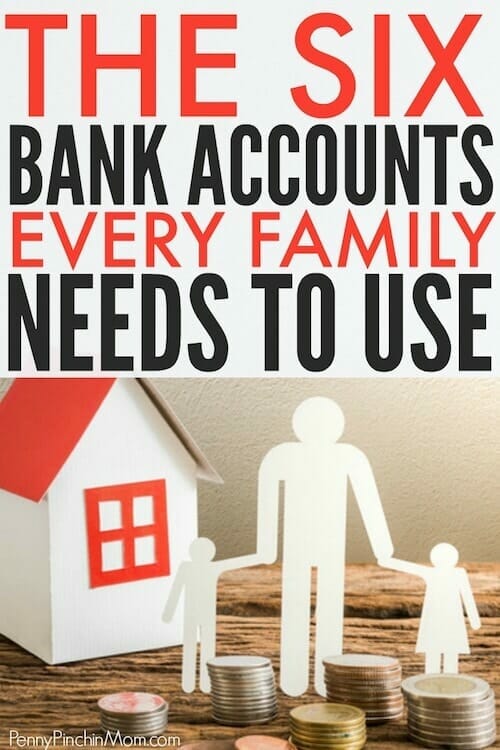There are at least six accounts every family needs to have. Of course, most people have one or perhaps two accounts. However, that isn’t enough.
If you have a checking and a savings account, then you are on the right track, but you need to do more. In fact, you should look at having at least four more accounts.
Six accounts? Are you serious?
Yes. Yes, I am.
Now, before you think I am crazy, allow me to explain why. It has to do with helping you better budget and track your money. We do this for our family, and it is great. We know which account pays which expenses.
You may think that you need to have a lot of cash to do this. However, that is not even remotely true. In fact, it may also help you with your finances more if you are struggling to make ends meet.
Other articles to help your family with finances:
- How to Talk with Your Spouse or Partner About Money
- 12 Money Lessons Every Child MUST Learn
- Ideas to Quickly Boost Your Emergency Fund Savings
- 10 Must-Know Personal Finance Tips for Mom’s Financial Success
WHY YOU NEED MULTIPLE BANK ACCOUNTS FOR BUDGETING
Look at it like this. Let’s say you own 20 pairs of socks and they are all different colors. Instead of folding them and putting them into your drawer, you toss them into a big pile. The morning comes, and you need socks. However, you need to find the blue socks.
You have to search through a massive pile of socks to try to locate the ones you need. You will, of course, find them. However, it may take you longer to do, and you may get frustrated in the process. Now, if those socks were all folded and organized, you would open the drawer and instantly find your blue socks. No stress. No worry.
The same concept is true for your money. You know which account is for emergencies, and which account pays the mortgage. This is a simple system which helps you organize your money. Using differen bank accounts for budgeting helps you keep better track of your money.
WILL THIS COST ME MORE?
Some of you may think that it will cost you money to have more accounts. That may be true if you do not maintain a minimum balance. However, in many cases, additional accounts are free. Your bank will also allow you to open several of them (and if they don’t, it may be time to look into getting a new bank).
Before you run down to your local bank or credit union, let me share the types of accounts you need to have.
HOW MANY BANK ACCOUNTS CAN YOU OPEN?
Your bank should not add any limits to the number of accounts you have for your family. Many welcome them as they understand the importance of having different accounts that have different purposes.
Sit down and speak with your banker about the additional costs associated with having several bank accounts for your family’s needs.
HOW MANY BANK ACCOUNTS SHOULD I HAVE?
While you can have as many as you would like, there are six accounts that every family should consider having and using to run their budget.
Regular Checking
Your regular checking account is the one for which you will pay your necessary household expenses. It includes items such as your mortgage, utilities, loans, etc. It is also the account where money is withdrawn to live on a cash-only budget.
Do not use this account for emergencies or other items which are listed below. It is the only account which will also have a debit card attached to it.
Emergency Savings Account
Your emergency savings account should be for, well, emergencies. Events such as the furnace needing to be replaced or to repair the broken window are the types of expenses this account will cover. These situations should be dire. Your vacation, birthdays or other known events should not be paid from your emergency fund.
Tips to make this account work:
- Savings should be automated. Set up an automatic deposit from your paycheck each month. If that is not possible, you can also arrange for an electronic transfer from your primary account into this one. The idea is to have it deposited into your emergency account before you have a chance to use it on something else.
- Determine the amount you should save. If you are new to creating an emergency fund, try to start out saving at least 5% of your paycheck. Slowly increase 1% per paycheck until you are up to 20% savings.
- Have a minimum of six months saved. You should be able to adequately cover at least six months of living expenses as a single person; nine months if you have a family. Ideally, everyone should have one full year of income saved. It can happen, it will just take time to do it.
- Keep the account out of site. Sometimes, seeing a large balance in an account can be tempting. You might want to use that for a great deal you found on an item you’ve wanted forever. Don’t do it. Try to keep the checks locked up so that you are not tempted to dig them out and use it; and also do not get a debit card for easy access.
Regular Savings Account
Your regular savings account is the one where you set aside money for any annual or other recurrent expenses. Here are examples of what you might put into your regular savings account:
- Life insurance premiums
- Auto insurance premiums
- Homeowner insurance premiums
- Home Owner’s Fees
- Vacation savings
- Birthday savings
- Furniture savings
- Auto repairs (tires, oil changes, etc.)
You should not access this account regularly. However, it is also there to make sure you set money aside for the expenses you know will be coming your way.
Kids’ Accounts
Each of your children should have his or her bank account. Start out with a savings account, and when he or she is old enough, you can help them open a checking account.
Doing so teaches your child to save money for the car they may want when they turn 16, pay for college or even into the future when it is time to purchase a house.
It is wise to teach your child to save 10% of every dollar they earn; from an allowance, odd jobs or even birthday money! If you start teaching your child smart financial habits at a young age, they will know no different when they get out on their own.
Mad Money Accounts
You will have two mad money accounts; one for you and one for your spouse. Each of us is allowed to spend money on anything we want, as long as we pay for it from funds from this account. You can keep this either in the bank or use cash envelopes (which is what we did).
My husband and I sat down and looked over our budget. We determined the amount from our budget that would work for both of us. Each payday, a small amount is put into our individual cash envelopes.
We can use this money for anything we like, without having to check with one another (within reason, of course). It is our mad or fun money. I used mine to decorate my kids’ rooms and my husband spent his on a hunting trip with his friends.
Health Savings
Many employers offer health savings accounts where you can set back a portion of each paycheck to use towards deductibles and other health-related expenses each year. While it is great as it is taken out pre-tax, if you do not use it all, you will lose it.
If you do not have such a plan through your employer, then it is up to you to save money each month to cover medical expenses. Here are some things to keep in mind:
- Enough to include at least 12 months of medications.
- Your deductible. One emergency and you could hit your deductible; so make sure you have this amount saved.
- Never allow your account to drop below the total needed for one year’s expenses.
The above is just a guide for the accounts my family uses. It works for us, but you may find that you need more accounts than this. There is no right or wrong number. However, don’t have too many, or that may be too daunting to maintain.
For our family, having six types of accounts works perfectly. We know which account to use for every kind of payment we make. It has helped us with our budget, and we couldn’t imagine running our family’s finances any other way.

